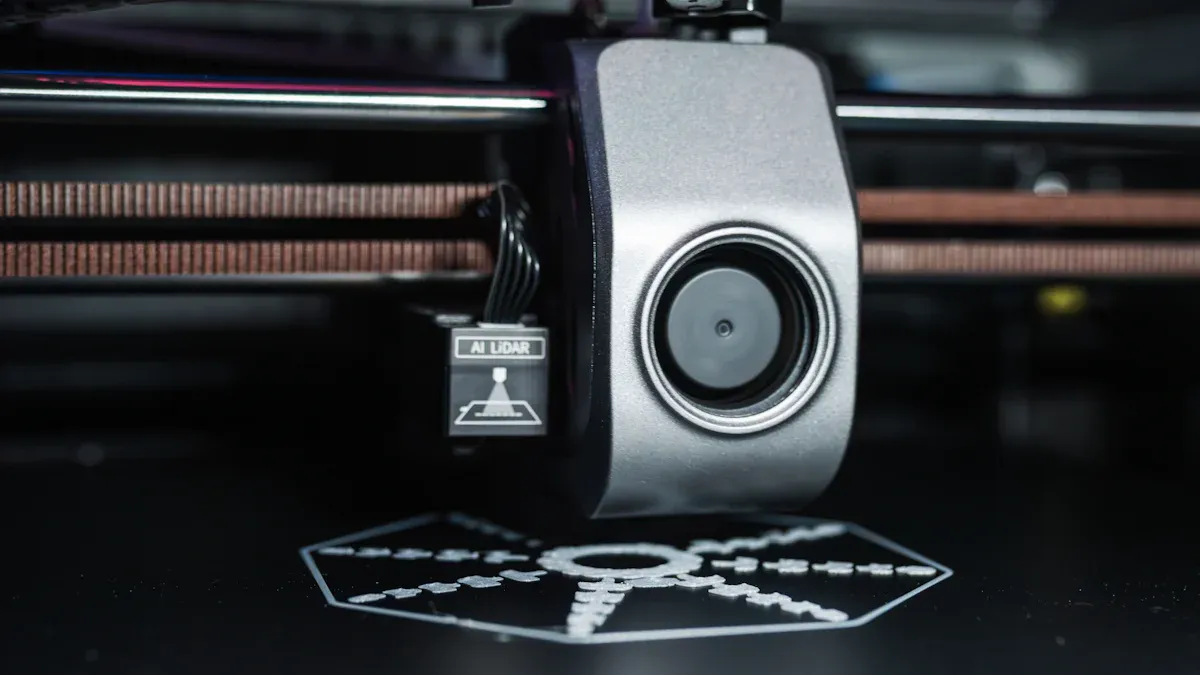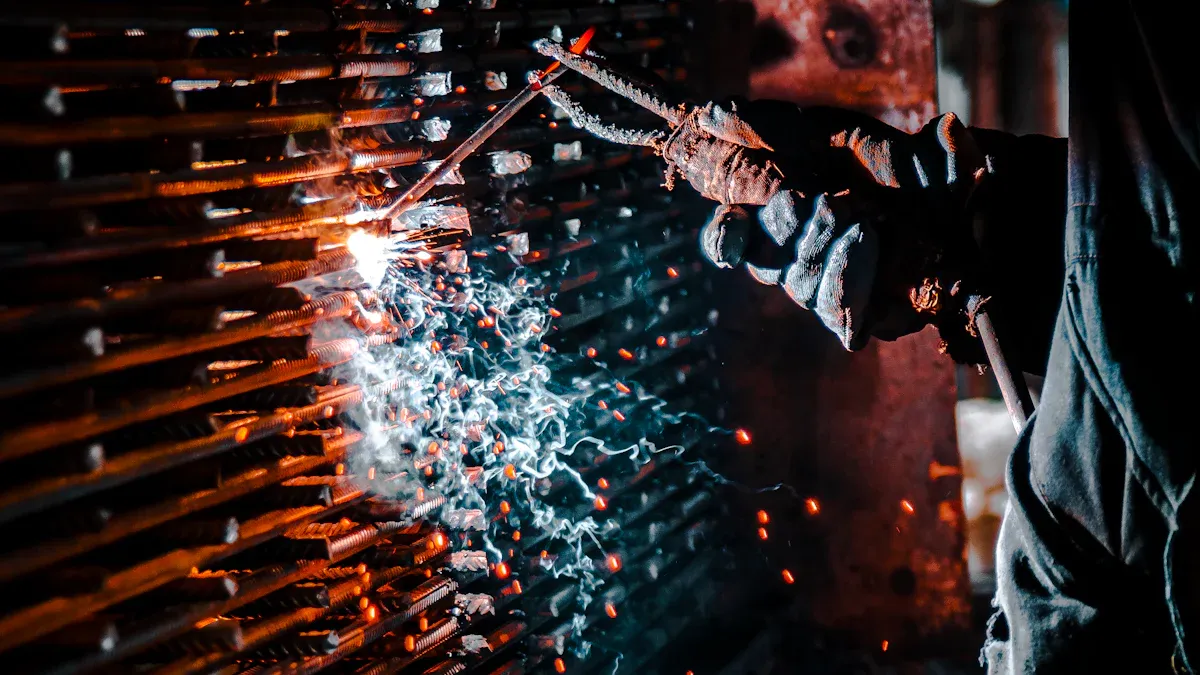
Sintered parts exhibit exceptional durability due to the unique sintering process. This method uses high temperatures below the material’s melting point to fuse powdered particles. Strong bonds form between these particles, creating a dense structure with superior mechanical and thermal properties. Studies show that reduced porosity enhances Young’s modulus and heat conductivity, further improving performance.
Key Takeaways
- Sintered parts are strong because heat fuses powder together tightly.
- They have high density and fewer tiny holes, making them tough.
- This strength helps them handle heat and pressure in tough jobs.
- Adjusting heat and powder size is key to making good parts.
Understanding the Sintering Process

What is sintering?
Sintering is a manufacturing process that transforms powdered materials into solid components by applying heat and, in some cases, pressure. This process occurs at temperatures below the material’s melting point, allowing particles to bond without liquefying. The driving force behind sintering is the reduction of free energy, achieved by decreasing surface area and forming new solid-solid interfaces. Atomic diffusion plays a critical role, enabling material transfer and pore elimination.
The process enhances properties such as strength, thermal conductivity, and electrical conductivity. For example, industrial procedures often involve mixing materials into a slurry, spray-drying, molding, and then sintering to create dense, high-performance components.
How heat and pressure create strong bonds
Heat and pressure are essential in sintering, as they facilitate the densification of materials. Heat increases atomic mobility, allowing atoms to diffuse across particle boundaries. This diffusion forms “necks” between particles, which grow over time, strengthening the structure. Pressure further compacts the material, reducing porosity and enhancing particle contact.
The combination of heat and pressure drives changes in free energy, leading to the formation of strong, solid-solid interfaces. This mechanism ensures that sintered parts achieve high density and structural integrity, making them suitable for demanding applications.
Why sintered parts don’t fully melt
Sintered parts do not fully melt because the process relies on solid-state diffusion rather than liquefaction. During sintering, only the surfaces of particles experience localized diffusion, forming necks that connect them. Microscopic analyses confirm that significant melting does not occur, as the material retains its solid-state characteristics.
Thermal imaging studies also reveal minimal melting during sintering, supporting the observation that densification occurs through solid-state mechanisms. This controlled process ensures that sintered parts maintain their shape and structural stability, even under high temperatures.
Key Properties of Sintered Parts
High density and reduced porosity
Sintered parts achieve high density through a meticulous process that minimizes porosity. During sintering, powdered materials undergo densification as voids between particles are filled. Grain density increases, and mass movements repack the material, reducing total pore volume. Studies on copper particles demonstrate that this process can lead to near-full density, significantly enhancing mechanical properties like Young’s modulus and thermal conductivity.
Note: Technical reports highlight that by the intermediate sintering stage, parts reach approximately 92% density, resulting in a homogeneous microstructure. This density distribution correlates closely with experimental measurements, as confirmed by coupled DEM and FE modeling techniques.
The reduction in porosity not only strengthens the material but also improves its electrical and thermal conductivity, making sintered parts ideal for applications requiring high performance and reliability.
Structural integrity and particle bonding
The structural integrity of sintered parts stems from the strong bonds formed between particles during the sintering process. Atomic diffusion facilitates the development of necks between neighboring particles, which grow over time to create robust solid-solid interfaces. The bond area relative to particle size plays a critical role in determining the strength and conductivity of the final component.
- Early sintering stages involve particle translation and rotation, contributing to bonding strength.
- Interfacial and bulk diffusion processes reshape pore morphology, further enhancing structural integrity.
- Controlled temperature and grain size ensure optimal bonding without excessive grain growth, which could compromise performance.
These mechanisms result in durable components capable of withstanding mechanical stress and maintaining their shape under demanding conditions.
Thermal stability and resistance to melting
Sintered parts exhibit exceptional thermal stability due to their dense microstructure and strong particle bonds. The sintering process enhances thermal conductivity while maintaining the material’s solid-state characteristics. Irregular particle coatings have been shown to improve heat transfer coefficients, outperforming spherical particles at similar porosities.
Tip: Key factors such as coating porosity, pore diameter, and effective thermal conductivity significantly influence the boiling heat transfer coefficient and critical heat flux (CHF).
This thermal stability ensures that sintered parts resist melting even at high temperatures, making them suitable for applications in extreme environments, such as automotive engines and industrial machinery.
Factors That Enhance Durability

Material selection and properties
The choice of material significantly influences the durability of sintered parts. Materials like sintered bronze, stainless steel, and copper are widely used due to their unique properties. Sintered bronze, for instance, is ideal for bearings because its porosity facilitates lubricant flow. Stainless steel and bronze serve as filter materials in high-temperature environments, such as steam filtration in food and pharmaceutical industries. Sintered copper, on the other hand, excels in heat pipes, where its porosity enables liquid movement through capillary action.
Research highlights the role of porosity in determining mechanical properties. Studies analyzing the microstructure of sintered materials reveal that pore shape and distribution directly affect elastic properties. Synthetic modeling of representative volume elements (RVE) confirms that reducing porosity enhances strength and performance.
Controlled sintering conditions
Precise control over sintering conditions ensures high-quality, durable parts. Factors such as temperature, particle size, and material composition play critical roles in achieving optimal results. The table below summarizes key findings:
| Evidence Description | Key Factors Involved |
|---|---|
| Grain-boundary and volume diffusion improve with controlled temperature. | Temperature, particle size, sintering environment properties. |
| Bond area to particle size ratio impacts strength and conductivity. | Initial grain size, temperature. |
| Densification reduces porosity, enhancing mechanical strength. | High relative density, small grain size. |
These parameters ensure reduced porosity, improved grain structure, and enhanced mechanical properties, making sintered parts reliable for demanding applications.
Post-sintering treatments for added strength
Post-sintering treatments further enhance the durability of sintered parts. Techniques like mechanical densification and heat treatment improve fatigue strength and fracture toughness. For example, surface-densified and heat-treated sintered gears achieve load-bearing capacities comparable to conventional gears.
Material testing laboratories confirm these benefits through methods such as hardness testing, grain size analysis, and thermal conductivity evaluation. These tests validate the effectiveness of post-sintering treatments in improving structural integrity and extending the lifespan of sintered components.
Sintered parts resist crumbling or melting due to the strong bonds formed during the sintering process. This method creates dense, durable components with excellent thermal stability. Their reliability makes them suitable for demanding applications. Understanding the sintering process underscores its critical role in manufacturing high-performance materials for modern industries.
FAQ
What makes sintered parts more durable than cast parts?
Sintered parts achieve higher density and reduced porosity through controlled processes. These factors enhance their mechanical strength and thermal stability compared to cast components.
Can sintered parts withstand extreme temperatures?
Yes, sintered parts resist high temperatures due to their dense microstructure and strong particle bonds. This makes them suitable for demanding thermal applications.
Are sintered parts environmentally friendly?
Sintering minimizes material waste by using powdered metals efficiently. Additionally, the process consumes less energy compared to traditional melting methods, reducing its environmental impact.
